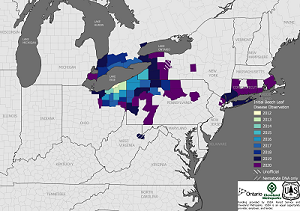The Michigan departments of Natural Resources and Agriculture and Rural Development today announced the addition of beech leaf disease to the state’s invasive species watch list.
Invasive species on the watch list have been identified as posing an immediate or potential threat to Michigan’s economy, environment or human health. These species either have never been confirmed in the wild in Michigan or have a limited known distribution.
Beech leaf disease is associated with the microscopic worm Litylenchus crenatae, a nematode that enters and spends the winter in leaf buds, causing damage to leaf tissue on American beech and European and Asian beech species. Infestations result in darkened, thick tissue bands between leaf veins, creating a striped effect on the leaves, leaf distortion and bud mortality. Trees weakened by leaf damage become susceptible to other diseases and can die within six years.
 Beech leaf disease has not been found in Michigan. The disease was first discovered in Ohio in 2012. Since then, it has been identified in seven eastern states and Ontario. Michigan is home to approximately 32 million American beech trees. Recognizable by their smooth bark, they are an important component to forests, providing food and shelter for wildlife. The disease’s proximity to Michigan, its potential rapid spread through the region and its devastating effect on beech trees, already under attack from beech bark disease, provide the rationale for inclusion on the watch list. |
Another cause for concern is that very little is known about the disease. Scientists are still working to understand if the Litylenchus crenatae nematode is the primary cause of the disease or the carrier of another causal agent responsible for the disease.
“Many questions about beech leaf disease remain unanswered,” said Simeon Wright, DNR forest health specialist. “Because of this, we don’t yet know all the ways the disease might be spread, and currently there are no known treatments to protect trees or reduce disease impacts. We are working with the U.S. Forest Service, several other states, Ontario and Michigan State University to better understand the disease and the potential effects it will have in Michigan’s forests.”
The microscopic nematodes cannot move long distances on their own. It is possible that the disease can spread through the movement of infested nursery stock and other beech material containing leaves and buds. As a precaution, beech trees, tree material and firewood should not be moved from areas of known infestation.
What to look for
 The most evident symptom of beech leaf disease is darkening and thickening of leaf tissue between the veins. This striping or banding can best be seen by looking upward at the tree canopy on a bright day. As the disease progresses, leaves may pucker or curl. While leaves on some branches of the tree may show signs of infestation, others may remain healthy. Because it may take a few years for symptoms to become apparent, the disease may become established in a large area before it is detected; however, detection is important to help slow further spread. |
What you can do
Striping on leaves becomes visible at leaf-out (when a tree or plant sprouts and opens leaves). DNR and MDARD encourage monitoring for any signs of the disease. If you suspect you have found a symptomatic tree, take one or more photos of the infested tree, including close-ups of affected leaves, note the location, date and time, and report it to:
- DNR Forest Health Division: DNR-FRD-Forest-Health@Michigan.gov or 517-284-5895.
- Or use the Midwest Invasive Species Information Network (MISIN) online reporting tool.
- Or download the MISIN smartphone app and report from your phone – MISIN.MSU.edu/Apps/#Home.
Be aware of look-alike diseases
Some other, more common diseases of beech trees may be mistaken for beech leaf disease. Be familiar with these and do not report them. Each can be managed by regular tree maintenance or with the help of a certified arborist.
- Beech leaf curl aphid causes puckering and curling at the leaf margin, with aphids or their cast skins usually visible inside the curled areas of the leaf, but usually isn’t harmful to tree health.
- Erineum patch, caused by eriophyid mites, creates light green or yellowish to orange patches on the upper side of the leaf, rarely affecting overall tree health.
- Anthracnose creates small brown or black spots on leaves that eventually cause dead areas. New leaves may curl. Fungi infect leaves and stems and are most active in wet spring seasons, with a limited impact on tree health.
- Powdery mildew, affecting many trees and shrubs, causes beech leaves to turn yellow. It may cause defoliation but won’t kill beech trees.
For more information on beech leaf disease and other species on Michigan’s watch list, visit Michigan.gov/Invasives.
